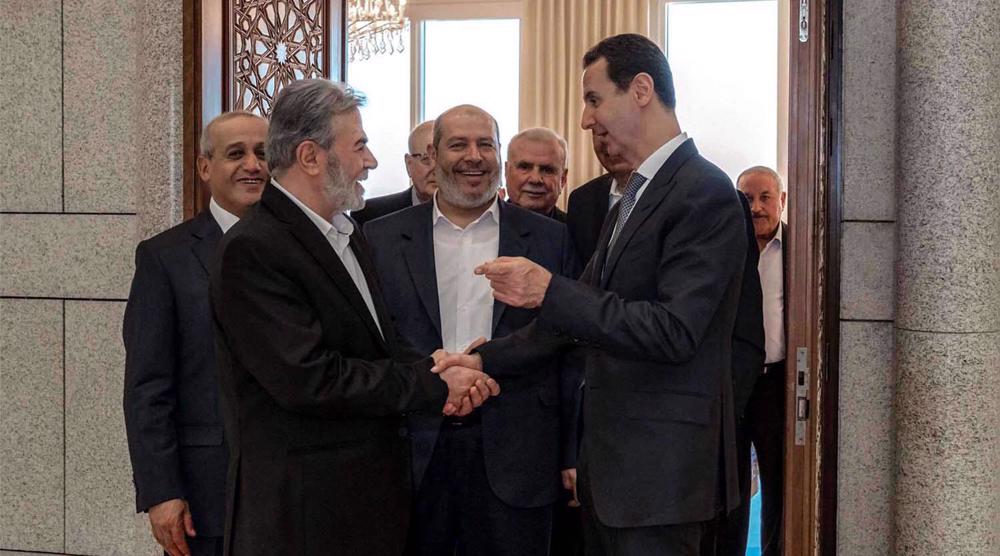Hamas-Assad reconciliation: A unity of arenas
By Hiba Morad
The then-US Secretary of State Condoleezza Rice’s infamous prediction about “birth pangs of a new Middle East” in 2006 has over the period turned out to be remarkably wide of the mark.
A delegation of the Palestinian resistance movement Hamas recently met with Syrian President Bashar al-Assad in Damascus in the first such visit in more than a decade as the two sides seek to revitalize their ties.
It won't be exaggeration to say that Hamas, which was the missing component of the Axis of Resistance, is well and truly back, with a proverbial bang.
The emerging scenario with Hamas-Syria reconciliation has understandably caused jitters in the US and Tel Aviv. Hamas, along with other Palestinian resistance factions, Syria, Hezbollah, Iran, and Yemen, constitute a stronger resistance front against the child-murdering occupying regime and its Western backers.
US fails to dismantle the Axis of Resistance
The much-awaited rapprochement has effectively nullified past disagreements and foiled "strategic expectations" of the US-choreographed so-called Arab Spring in terms of further destabilizing the region.
It has also destroyed the hegemonic ambitions of the US military-industrial complex in the region through diverse and comprehensive foreign policy.
According to Lebanese sociologist and political analyst, Dr. Talal Atrissi, the Hamas-Syrian government reconciliation proves that desperate US attempts to sow seeds of sectarian discord in the region and dismantle the resistance bloc have been thwarted.
With the return of Hamas, a popular resistance movement in the Arab world, the Axis of Resistance is complete again and more steadfast than ever, Dr. Atrissi told Press TV Website in an interview.
He said many international and regional players have been trying to create fissures in the Axis of Resistance by fanning the flames of sectarianism inside Syria and even outside it.
Mainstream media outlets, journalists, and political pundits have been hell-bent on widening the gap between the Hamas movement and the Axis of Resistance, especially in Syria, to reinforce that Hamas is not a component in the body of the transnational resistance axis, the political analyst noted.
It is worth noting that despite disagreements between the Palestinian resistance movement and Syrian President Bashar al-Assad, Hamas did not abandon its role of resistance against the Israeli occupation regime throughout the past decade.
Despite differences or disagreements, certain principles and obligations remain constant in the resistance bloc. The most important being the elimination of the Israeli apartheid regime and liberation of the occupied Palestinian territories.
A New regional scenario
Operation al-Quds Sword marked a giant leap in the ability of Palestinian resistance factions to fight the Israeli occupation, and today’s return of Hamas to the fold of the resistance axis represents a watershed moment.
Dr. Atrissi underscored that the meeting between the Hamas leadership and the Syrian government officials will change the regional dynamics.
Assad’s realigning with Hamas includes potentially improved relations with the movement's allies Qatar and Turkey, whose relations with Syria remain shaky.
“The reconciliation will pave the way for better relations between Syria and Hamas’s allies, Qatar and Turkey, and that itself will also have an impact on the region,” Dr. Atrissi told the Press TV Website.
And it is not just relations at the regional level that would improve; there will be a situation which the analyst described as "a Unity of Arenas".
“We are talking about a Unity of the Arenas here. The Palestinian arena was united since Operation al-Quds Sword; which led to the setting up of a joint operation room that brings Palestinian resistance factions together," he remarked.
"Now, there is also another joint operations room but this time outside Palestine, which brings together the Palestinian resistance factions, Iran, and Hezbollah in Lebanon together."
With that, the return of Hamas to Syria intensifies joint operations in terms of leadership, mapping, and execution of plans and operations.
US-Israel fear escalating
Not only will the return of Hamas allow the Axis of Resistance to upgrade itself to another level and develop its capabilities further, but it will also deepen American and Israeli fears and worries.
“This reality makes things tougher for the Israeli regime, especially in light of the heroic operations and the uprising we are witnessing inside the occupied West Bank,” Dr. Atrissi stressed.
The analyst hastened to add that the fear among Americans due to the recent reconciliation is logical. The US sees the Axis of Resistance as a group of "terrorist organizations" which threaten the security of the illegitimate entity occupying Palestine.
“Such an Axis of Resistance is without a doubt a straightforward threat to the Israeli regime," he said.
The reunion of the Axis of Resistance is bound to foil all US efforts including so-called normalization between the Israeli regime and some Arab countries or the so-called Deal of the Century on the one hand and puts the Israeli regime's security and future at risk.
“The US anxiety is due to its fear for Israel’s security, and due to the fact that its schemes in the Middle East region have failed,” Mr. Atrissi asserted.
This reconciliation seems to compound the woes and worries of the US further, especially as it is involved in war against Russia and China for global supremacy.
The analyst further said that Syria has always represented a strategic depth to Palestine and has always backed Palestinian resistance movements.
"Today, owing to this reconciliation, Hamas is back at the forefront. In any future confrontation, Israel must calculate things correctly and understand that Syria will be part of any coming confrontation. Such calculations did not exist prior to the reconciliation," he said.
Dr. Atrissi also referred to indefatigable efforts by the Islamic Republic of Iran, Lebanese resistance movement Hezbollah and Iran's top anti-terror commander Gen. Qassem Soleimani in forging reconciliation between Syria and Hamas.
“Iran, Hezbollah, and Haj Qassem Suleimani all have a strategic goal of preserving relations with Hamas and bringing it back on board; and the main strategic goal of the Axis of Resistance is the liberation of Palestine, all Palestine, and ending Israeli apartheid,” he said.
Hiba Morad is a Tehran-based academic and political analyst, currently pursuing a PhD in linguistics at the University of Tehran.
US House passes bill targeting charities and pro-Palestine groups
Hezbollah attacks Israeli forces after Lebanese homes blown up
World leaders, states hail ICC arrest warrants for Netanyahu, Gallant
MP: US accountable for possible Israeli 'foolishness' to attack Iraq
VIDEO | Israeli policies strangle Palestinian agriculture, economy
Iran's president offers condolences to Pakistan over terrorist attack
Canada’s Yukon town council at standstill over refusing oath to King Charles
Yemen's Houthi calls for jihad to protect Palestine against Israel













 This makes it easy to access the Press TV website
This makes it easy to access the Press TV website